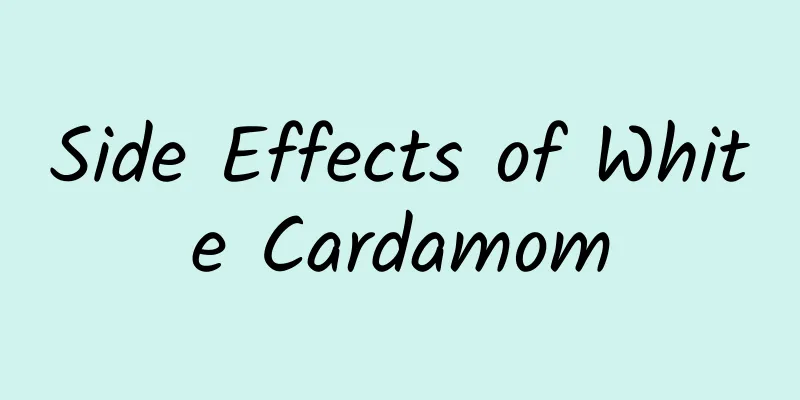Side Effects of White Cardamom

|
White cardamom is a plant belonging to the ginger family category. White cardamom is mainly produced in countries such as Vietnam and Thailand, and is also grown in Guangdong, Guangxi and Yunnan in my country. White cardamom needs to grow in areas with warm and humid climates. White cardamom can not only be used as food, but also used more as medicine. Therefore, we must understand the medicinal value of white cardamom and know how to use it. The medicinal value of white cardamom is very high. We can use white cardamom to treat nausea caused by cold stomach, regulate stomach qi, treat vomiting during pregnancy, and it can also be beneficial for children with vomiting of milk and cold stomach. However, we should pay attention to the side effects of white cardamom. The stems are clustered, the plant is 3 meters tall, and the leaf sheaths at the base of the stem are green. The leaves are ovate-lanceolate, about 60 cm long and 12 cm wide, with a pointed tip, smooth and glabrous on both sides, and nearly sessile; the ligule is round, 7-10 mm long; the sheath mouth and ligule are densely covered with long coarse hairs. The spike inflorescence emerges from the rhizome near the base of the stem. It is cylindrical, rarely conical, 8-11 cm long, 4-5 cm wide, and densely covered with bracts arranged in a shingle-like manner; the bracts are triangular, 3.5-4 cm long, straw yellow, with obvious lattice-like reticulation; the bracteoles are tubular, cracked on one side; the calyx is tubular, white with a slight reddish color, covered with long soft hairs, with three teeth at the apex, the corolla tube is nearly the same length as the calyx tube, the lobes are white, oblong, about 1 cm long, about 5 mm wide; the lip is elliptical, about 1.5 cm long, about 1.2 cm wide, yellow in the center, concave, with yellow-brown edges, and a petal stalk at the base; the stamens are recurved, the connective appendages are three-lobed, about 3 mm long; the ovary is covered with long soft hairs. The capsule is nearly spherical, about 16 mm in diameter, white or light yellow, slightly obtusely triangular, with 7-9 shallow grooves and several slightly raised longitudinal lines, with yellow coarse hairs on the top and base, the pericarp is woody and easily cracked into three petals; the seeds are irregular polyhedrons, about 3-4 mm in diameter, dark brown, with shallow seed grooves, and have an aromatic smell. Flowering period: May; Fruiting period: June-August. Function and indications Eliminate dampness and promote qi circulation; warm the middle and stop vomiting; stimulate appetite and aid digestion. It is mainly used for dampness blocking Qi stagnation; spleen and stomach disharmony; abdominal distension; loss of appetite; the initial stage of damp-heat; chest tightness without hunger; stomach cold and vomiting; indigestion. Additional prescription ①To treat vomiting and pain caused by cold appetite: 3 grams of white cardamom seeds. Grind it into powder and drink with wine. ("Red Water Pearl" White Cardamom Powder ②To treat cold stomach and vomiting after eating: pound three white cardamom seeds, sieve and grind them into fine powder, add a cup of good wine, slightly warm it and drink three or two cups. ("Emergency Prescription") ③ Treat disharmony of spleen and stomach, stop spleen diarrhea and dysentery: 2 liang of white cardamom (use kernels, half raw and half cooked), 0.5 jin of Citrus aurantium (remove the pulp, boil with starch water until soft, stir-fry with bran until fragrant), 2 liang of cinnamon (peeled), 2 liang of tangerine peel (remove the pulp, stir-fry, and cut into small pieces), 2 liang of Terminalia chebula (remove the core, half raw and half cooked), 2 liang of Chinese angelica (washed). Grind the above six ingredients into powder. Take one qian of it each time with one medium cup of water. Fry ginger and dates together until 70% done, and drink when slightly warm. If you want to make pills, use good dates, boil them in water, remove the skin and core, grind them finely, and make pills as big as tung nuts. Break the ginger into pieces, stir-fry until it turns black, add water and boil it, then take 15 pills. (Bai Dou Kou San from Bo Ji Fang) ④ Treat qi stagnation, spleen and stomach, and no appetite: 2 liang each of white cardamom seeds and amomum villosum, 1 liter of old rice (washed, briefly blanched, and fried in a pot), 0.5 liang of cloves (not exposed to fire). Grind the above ingredients into fine powder and make pills with the jujube meat as big as small red beans. Take 50, 70 to 100 pills each time, with rice water. (Taicang Pills from Wei's Family Prescriptions) ⑤Treat vomiting during pregnancy: 1 qian of white cardamom, 3 qian of bamboo shavings, 3 jujubes, and 1 qian of fresh ginger. Crush the ginger to extract the juice. Boil the first three medicines into a cup (about 50-60 ml), filter it, and drink it with ginger juice. (Wuhan Medical and Health (3): 288, 1959) ⑥To treat vomiting of milk and stomach cold in children: 14 white cardamom seeds, 14 Amomum villosum seeds, 2 qian of raw licorice, 2 qian of roasted licorice, grind into powder and put it into the child's mouth frequently. (The Effective Prescriptions of Worldly Doctors) ⑦ Treat vomiting and retching: white cardamom, patchouli, pinellia, tangerine peel, and ginger. Decoction in water. (White Cardamom Soup from Shen's Book of Life) ⑧Treat postpartum hiccups: half a liang each of white cardamom and cloves. Grind into powder, take one qian of it with peach kernel soup, and then take it again after a while. ("Qian Kun Business") Above we introduced what white cardamom is. The edible value and medicinal value of white cardamom are very high. We can use white cardamom to treat many diseases in daily life, but we should not ignore the side effects of white cardamom. The side effect of white cardamom is that people with yin deficiency and blood dryness but no cold and dampness should not eat it. |
Recommend
Comparison of Amazon and Apple eBook pricing models - Infographic
I have previously written a post comparing the e-...
Because of it again! A girl was admitted to the ICU with a skull fracture. Don’t use this “deadly internet celebrity jewelry” anymore
For girls with long hair, the most indispensable ...
What are the effects and functions of Semen Cassiae?
In the field of traditional Chinese medicine, Lit...
How come my eyes became nearsighted when they are in good condition?
Mixed Knowledge Specially designed to cure confus...
Does safflower have the effect of weight loss?
Safflower is a type of flower. It is not common i...
Is pelvic floor rehabilitation not necessary for caesarean sections? Is it necessary to eat a lot of meat and fish during confinement? Tips for new mothers
Mother's Day is approaching quietly. For many...
What is Astragalus
Astragalus is a very common Chinese medicinal mat...
What are the medicinal values of golden and silver wood
Honeysuckle is also known as honeysuckle. Its fru...
A bowl of Yulin rice noodles contains the mountains and rivers of Lingnan
Written by Wei Shuihua Header image | TuChong Cre...
Ammonia treatment administrator: Why can this battery save fish lives?
Author: Duan Yuechu Ammonia is a toxic compound t...
9032 meters! The second Qinghai-Tibet scientific expedition set a world record for atmospheric science observation by airship
The picture shows the Jimu-1 III airship in front...
What is it like to have an international award at the entrance of the village? | Great Power Technology
What is it like to have a super-large bridge in t...
Taboos of Mistletoe
Mistletoe is a very common Chinese medicinal mate...
The efficacy and function of Tuanhua
Tuanhua is a medicinal material that can treat ma...









